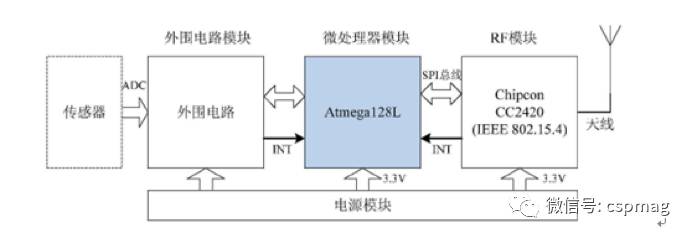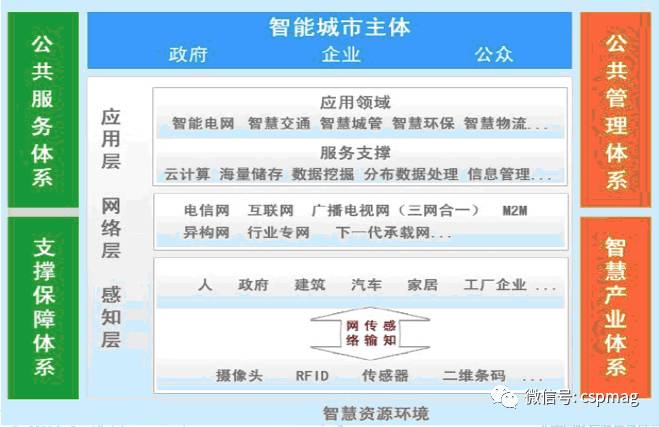
With the continuous improvement of scientific and technological levels, the construction of smart cities based on the Internet of Things (IoT) broadly refers to the intelligent information management of urban areas. It utilizes technologies such as IoT, big data, and cloud computing to process, analyze, and manage cities through intelligent means. The construction of smart cities based on IoT employs advanced technologies to enhance urban governance, improve the overall rapid response capabilities of the government, and elevate the modernization level and socio-economic benefits of urban construction and management. This article will focus on the application of IoT technology in smart city management.
I. Main Technical Routes of IoT in Smart Cities 1. Sensor Network Devices and Protocols
(1) Hardware Design of IoT Wireless Nodes
The hardware of wireless nodes includes: microprocessor module, wireless communication module, and power module. The microprocessor module is mainly used to run network protocols and control peripheral devices such as RF chips; the wireless communication module provides wireless communication capabilities for each node, converting digital signals to radio signals; the power module is primarily responsible for providing and managing energy for the entire system, as shown in Figure 1.

Figure 1
(2) Software Design of IoT Wireless Nodes
The software structure of wireless nodes is based on a hierarchical architecture of the TinyOS operating system, mainly divided into the protocol stack and hardware abstraction layer. The wireless network nodes use the CC2420 RF chip to achieve wireless communication between nodes. Since the RF chip is the most power-consuming part of the wireless network node, the quality of its driver design directly affects the communication capability of the entire wireless network node and the lifespan of the node. The data stored in the EEPROM of the sensor node mainly consists of the routing table and neighbor table. The routing table primarily stores target addresses and corresponding next-hop addresses, while the neighbor table mainly stores 64-bit extended addresses, network addresses, link quality (LQI), and relationships between nodes. Basic data collection is achieved through wireless sensor nodes that convert physical signal quantities from monitoring points into digital signals, implemented through various sensors and microcontrollers.
2. Multi-Protocol Fusion Gateway Software and Hardware Design
(1) Software Design of Fusion Gateway
The software design of each integrated system is based on the embedded Linux operating system platform, adopting modular programming. The Ethernet or fieldbus protocols to be implemented are divided into different modules according to their functions. The system chooses to use shared memory to pass configuration table information and shared data between processes. The lowest layer consists of hardware devices, namely the multi-bus fusion communication gateway hardware, followed by the kernel space, where the kernel space controls the functional components of the gateway through driver programs. On this basis, the driver program can conveniently standardize the control of various interfaces of the system. Above the kernel driver program is the device file, where Linux manages each driver and hardware through device files, typically corresponding to one device file for each actual hardware device. Device files are uniformly managed by Linux’s virtual file system, interacting with user space programs through Linux’s system call interface. Above the kernel space is the user space, where the lower layer mainly consists of the TCP/IP protocol stack and various communication protocol programs. These protocol programs can be high-level protocols of RS485 (Modbus, Profibus, etc.), application layer protocols of CAN (Canopen, Devicenet), and various high-level protocols based on Ethernet, as well as user-defined protocol programs based on RS232, RS485, CAN, and Ethernet. Each protocol program corresponds to a block of shared memory, managed uniformly by user application program interface functions. The top layer consists of user application programs, which manage each protocol program through API functions. The data processing module mainly extracts effective payloads from the data packets obtained from the wireless sensor network and Ethernet and performs related processing such as re-packaging. In the data processing part, both upstream data (data and event) and downstream data (command) need to be processed simultaneously, so we adopt a multithreading approach to achieve this, allowing for simultaneous processing of upstream and downstream data.
(2) Hardware Design of Fusion Gateway
The multi-protocol fusion gateway serves as a bridge for data transmission between wireless sensor networks and wired Ethernet, primarily used to collect data from wireless sensor networks, support various mainstream field buses, process this data, and forward it to Ethernet via TCP/IP protocol. Since the gateway needs to handle a large amount of data and also support USB communication and TCP/IP protocol, it requires a stronger CPU processing capability and larger memory space compared to IoT wireless sensor nodes. It adopts an ARM architecture embedded hardware platform, which needs to have a central processing module, memory module, and provide network interfaces for network communication, as well as UART serial ports, USB, and other interfaces for various monitoring field buses.
II. Development and In-Depth Applications of IoT Technology in Smart City Management Smart City System Architecture
Smart cities realize intelligent integration of urban comprehensive services and management, applying technological innovations such as big data, IoT, and cloud computing to urban smart services. The focus is on fully utilizing the technological framework of big data, IoT, and cloud computing to combine information communication technology with virtual systems in cyberspace, transforming traditional industrial services into smart services, and maximizing the added value of products during the urban smart service process. The integration of IoT and smart cities mainly focuses on innovative breakthroughs in wireless intelligent sensing technology, ubiquitous access technology, and intelligent big data processing technology, aiming to develop new types of sensors, intelligent sensing terminals, intelligent service terminals and systems, intelligent heterogeneous fusion access nodes, user service-oriented software-defined key technologies, and general control and intelligent business management platforms, as shown in Figure 2.
Smart City System Architecture

Figure 2
III. Development and Application of IoT Technology in Smart Cities
(1) Application of IoT Technology in Smart Urban Management
Comprehensive integration of information resources and business collaboration enables mutual perception and interconnection between people, people and objects, and objects, continuously improving management efficiency and effectiveness. Through intelligent means, enhance communication between smart urban management departments and people, making urban management services more convenient, faster, and more humanized.
Front-end sensors and other hardware devices utilize sensing technology to monitor and perceive the status of urban management facilities. The perception platform based on IoT technology is the foundational part of the entire smart city management system, serving as the data collection port for all information related to urban management, integrating software, hardware, and communication network applications, including location perception, video perception, status perception, service perception, and other information perception. Relying on the city’s network infrastructure, it enables the transmission of sensing signals and data. The IoT platform for urban management supports the storage, computation, and analysis of various data types (including status perception data, video perception data, location perception data, and various business data), providing data exchange services between urban management departments and relevant institutions through shared exchange interfaces of the infrastructure platform, and facilitating data exchange services between lower-level urban management departments and command centers. Finally, through a comprehensive application platform, it achieves correlation analysis, intelligent recognition, efficient integration, and panoramic display of monitoring information, supporting real-time early warning and event access, as well as the distribution display of law enforcement forces and command scheduling.
(2) Application of IoT Technology in Intelligent Security Systems
By collecting specific information from monitored areas through detectors, the devices mainly include cameras, smoke detectors, infrared sensors, vibration sensors, and various alarm detectors. The data from detectors and control information are transmitted remotely using the wide-area connectivity capabilities of the Internet. Through the intelligent analysis processing module deployed on the product, alarm information from a single detector is analyzed comprehensively with information collected from other detectors in the same area, achieving intelligent judgment of abnormal events. The application decision layer enables remote monitoring and management of the system. Based on the data derived from comprehensive analysis, users can monitor and manage the system through mobile terminals such as smartphones, tablets, and PDAs, allowing timely decision-making for abnormal events. IoT technology makes intelligent security systems smarter, faster, more accurate, more convenient, and more effective.
(3) Application of IoT Technology in Smart Communities
The construction of a smart community service platform based on IoT is an important measure to enhance comprehensive governance in communities using advanced technology, providing the government with rapid overall response capabilities and improving the ability to respond to and handle various emergencies. It can change the current management model of comprehensive governance in communities, opening a new path for comprehensive control and technology-enhanced policing, significantly improving the modernization level of community management.
The digital community service platform based on IoT mainly needs to address the standardization of services for various devices and systems in the supporting environment, providing a foundational framework and common components for upper-level community application systems, thereby enabling the access support of urban public facilities and specialized service facilities; achieving application integration across fields and industries, providing a collaborative working environment for key systems and participants in the city.
(4) Application of IoT Technology in Intelligent Transportation
Through automatic integration and intelligent sharing of information resources, with high analysis and prediction capabilities, it achieves convenient, safe, economical, and efficient transportation, supporting the operation of smart cities and economic development. Based on information technologies such as the Internet and IoT, it forms a new model of modern transportation development characterized by a complete traffic information network, intelligent transport equipment, and high transportation efficiency and service levels through sensing, interconnection, and intelligence. Fully utilizing information communication technology, it achieves a completely automated, rational, and efficient traffic management service state through mutual perception and intelligent interaction between people, transport equipment, and traffic networks, maximizing transportation efficiency and resource benefits.
(5) Application of IoT Technology in Smart Safety
Smart safety is based on the Internet and IoT, establishing a unified public safety system and emergency response mechanism through comprehensive perception of urban safety information, collaborative operation among subsystems, and resource sharing, achieving intelligent management of public safety through emergency linkage, unified scheduling, and command. Smart safety enhances the collection and processing of urban safety information through the installation and layout of cameras, sensors, RFID, and other sensing devices at important urban locations and key nodes, enabling real-time dynamic monitoring and prediction, effectively avoiding safety hazards.
Conclusion
The characteristics of smart city management based on IoT lie in the use of wireless sensors for data collection, breaking through the previous single video collection method, and changing the traditional urban security model of single video monitoring. Through cloud computing and big data technology, it provides heterogeneous data fusion and distributed management, sending terminal collected data to monitoring platforms for timely analysis and aggregation. Utilizing the rich and timely monitoring means of IoT and the multi-level management of data systems, smart cities will achieve unified command, timely response, and effective operations.